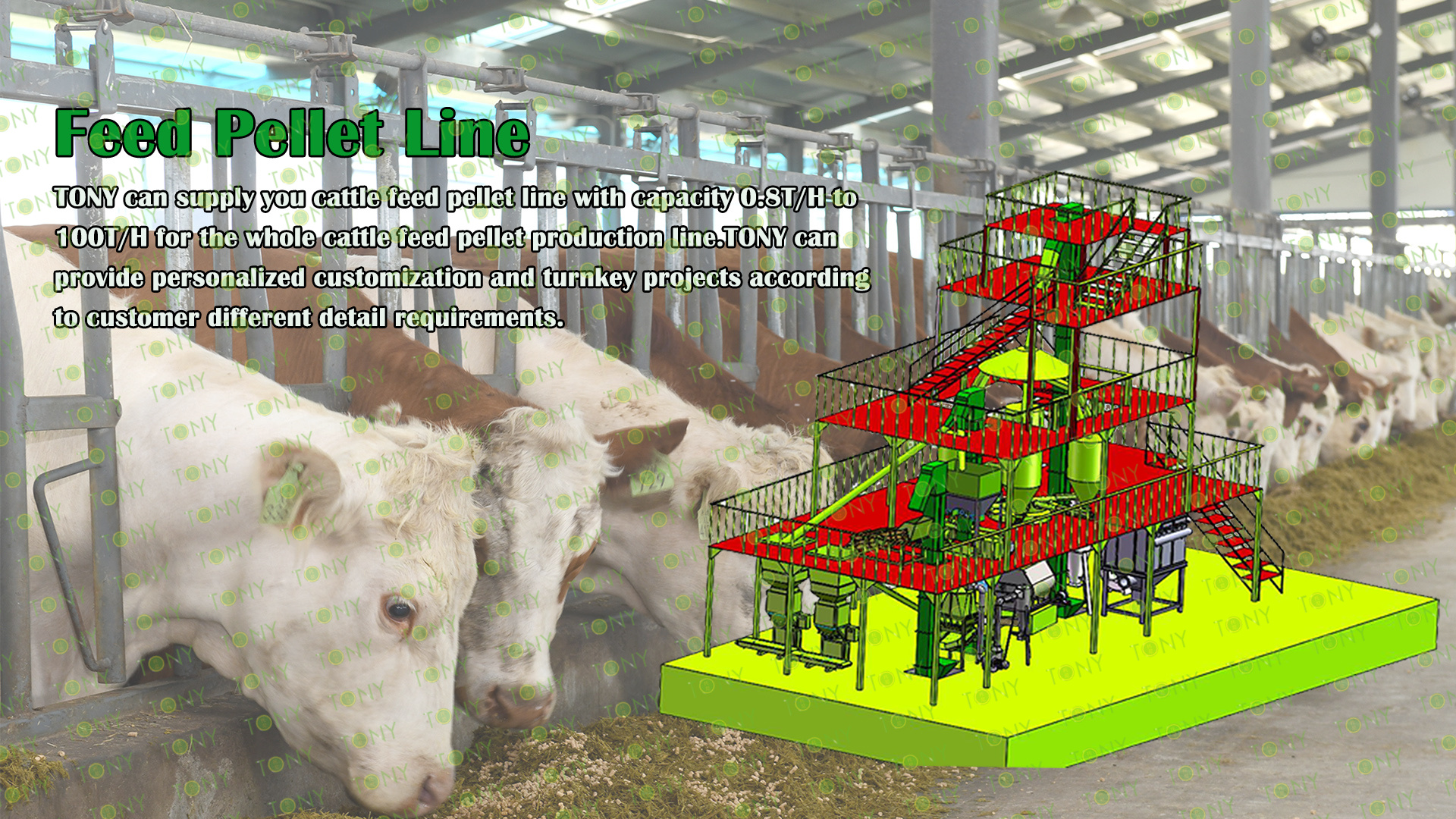
TONY Design 6-7Ton/Hour Cattle Feed Pellet Production Line Specification
Feed pellets have significant advantages in improving the digestion and absorption of cattle, saving feed, reducing disease, facilitating management and improving economic efficiency, so it is recommended to use feed pellets in the cattle raising process.Feed the cattle the benefits of feed pellets:
1. It Is Good For Digestion And Absorption
(1) Good Palatability: During the pressing process of feed pellets, starch gelatinization in the mixed powder can be made, so that feed pellets have a certain flavor, increase the palatability of feed, and stimulate the appetite of cattle.
(2) High Digestion And Utilization Rate: Smooth surface of feed pellets, high hardness, deep maturation, cattle like to eat, chew fully, high digestion and utilization rate, promote the growth and development of cattle.
2. Save Feed
(1) Reduce Waste: Feeding cattle powdered feed is easy to throw, easy to make cattle picky, especially in the wind when the feed flies, resulting in waste. After changing to feed pellets, cattle can not be picky, and the feed utilization rate can reach 99%.
(2) Balanced Nutrition: Pellet feed through professional formulation and processing, can ensure the various nutrients required by cattle, help to improve the growth and development of cattle and milk production.
3. Sterilization And Disinfection To Reduce Disease
(1) High Temperature Treatment: In the pressing process of pellet feed, after a short-term high temperature of up to 70 to 100 ° C, some parasitic eggs and pathogenic microorganisms can be killed, so that the disease of cattle is significantly reduced.
(2) Reduction Of Specific Diseases: Diarrhoeal diseases, stomatitis and pica were significantly reduced in cattle fed pellet feed.
4. Easy To Manage And Store
(1) Easy Storage: Pellet feed is easier to store and transport than bulk feed, which can reduce the possibility of food waste and feed deterioration.
(2) Good Fluidity: Granular feed has good fluidity, is not easy to adhere, and is easy to manage and automate feeding
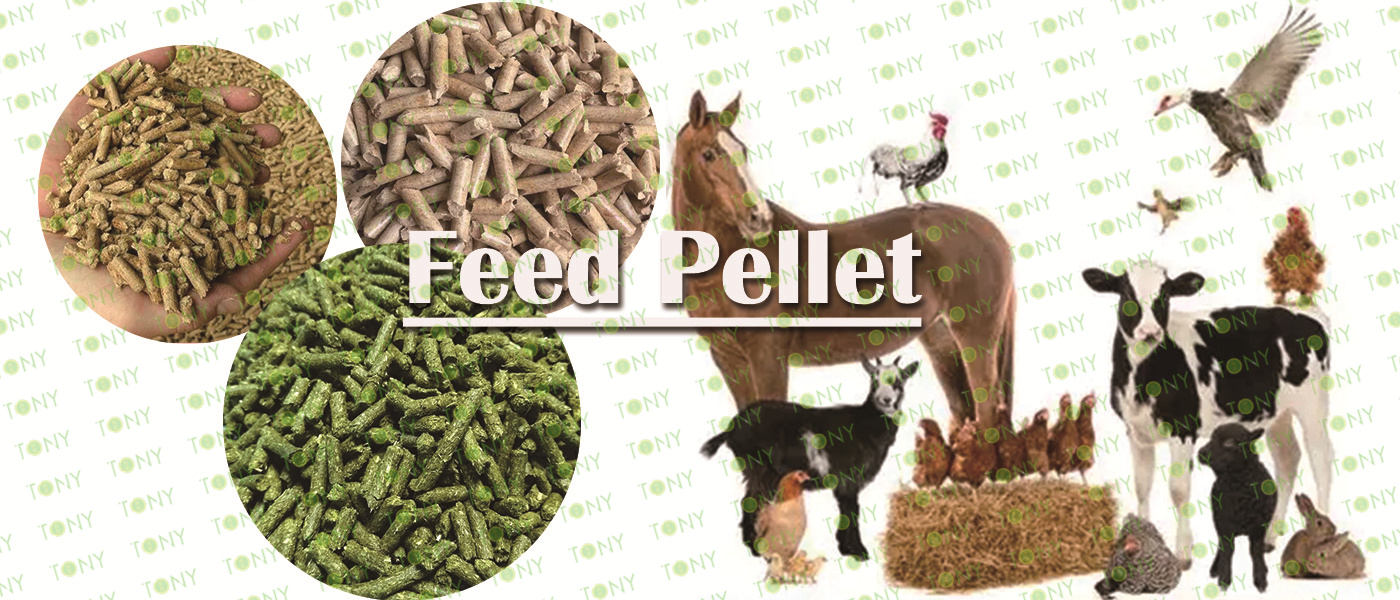
The difference between cattle eating formula feed and non-formula feed is mainly reflected in the following aspects:
1. Balanced Nutrition:
Formula feed is scientifically proportioned according to the nutrients required by cattle at different growth stages and production purposes (such as fattening, breeding, milk production, etc.). It usually contains a moderate amount of energy feed (such as corn), protein feed (such as soybean meal), mineral feed (such as calcium, phosphorus, salt, etc.), and other necessary trace elements and vitamins. This ratio ensures a more comprehensive and balanced intake of nutrients, contributing to healthy growth and efficient production.
2. Growth Efficiency:
After scientific matching of nutrients in formula feed, it can better meet the growth and production needs of cattle, thereby improving its growth efficiency and production performance. For example, fattened cattle fed a formula diet may gain weight faster and meat quality better than cattle fed an unmatched diet.
3. Health Status:
Formula feed is usually supplemented with ingredients that help the digestion and health of cattle, such as baking soda (to neutralize stomach acid), table salt (to supplement minerals), etc. These ingredients help maintain the digestive health of cattle, reduce the incidence of disease and improve overall health.
4. Economic Benefits:
Because the formula feed can improve the utilization efficiency of feed and the production performance of cattle, it can reduce the breeding cost and improve the economic efficiency to a certain extent. For example, cattle gain weight faster after eating formula feed, meaning that they can reach the threshing standard in a shorter time, saving on feed and breeding costs.
5. Environmental Impact:
The scientific ratio of formula feed can reduce nutrient waste, reduce the content of harmful substances in feces, and thus reduce environmental pollution. For example, a reasonable proportion of mineral feed can reduce the excessive intake and excretion of elements such as phosphorus, which helps to protect the environment.
In general, cattle eating formula feed can bring significant advantages over non-formula feed in terms of nutritional balance, growth efficiency, health status, economic benefits and environmental impact.
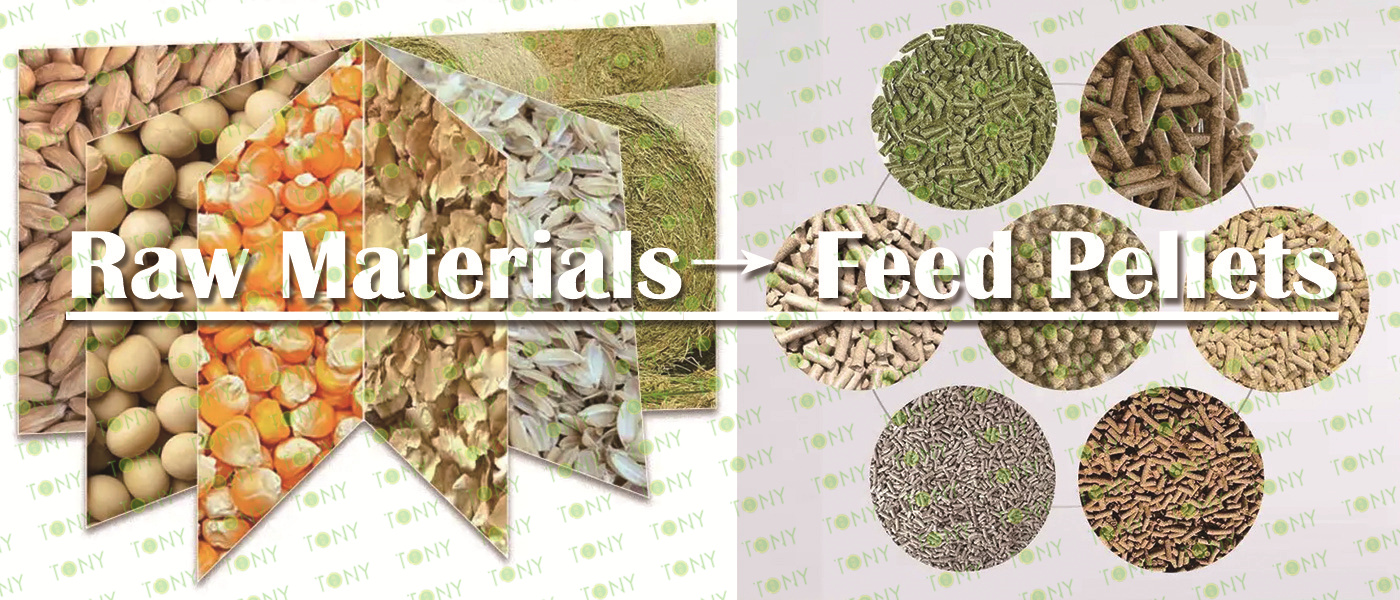

1. Meet The Needs Of Cattle Growth
(1) Provide Nutrition:
The growth, development, and reproduction of cattles require a variety of nutrients. For example, protein is an important part of cattle body. The construction of muscles and hair is inseparable from protein. The Cattle itself cannot synthesize sufficient protein and needs to be obtained from the feed. Botanical feed protein mulberry contains 28-36%of plant protein and is rich in 18 amino acids. It can be used as high -quality protein sources to supplement protein nutrients forcattles; fish powder and meat powder in cattle feed are also protein -rich feed -rich feed. Raw materials provide necessary nutrients for cattles.
(2) Maintain Element Balance:
The feed helps maintain the balance of calcium, phosphorus and other elements in the cattle. Calcium and phosphorus are very critical to the development of bones and maintaining normal physiological functions. If the proportion of calcium and phosphorus in the feed in the feed may cause health problems such as bone diseases in cattles, and appropriate feed can ensure the healthy growth of cattles.
(3) Provide Energy:
The daily activity of cattles requires energy sources. The carbohydrates and fats in the feed can provide energy for cattles. For example, oil -containing feed (such as rapeseed, peanuts and other oil -containing seeds), its energy is mainly from lipids. The energy density is higher than that of starch, which can meet the energy needs of cattles.
2. Promote Cattle Health
(1) Prevention Of Disease:
A reasonable feed formula can enhance the immunity of cattles and prevent the occurrence of diseases. For example, adding an appropriate amount of vitamins and trace elements to the feed can improve the disease resistance of cattles.
(2) Improve Digestion Function:
The composition and processing of feed can affect the digestion and absorption of cattles. The full -price feed treated by cooked chemistry is more likely to be digested and absorbed by Cattles, which helps the healthy growth of Cattles. For example, the full -price feed is fed and fed poultry and livestock. Poultry and livestock can better digest and absorb, thereby growing rapidly.
3. Improve Breeding Benefits
(1) Improve Production Performance:
High -quality feed can improve the production performance of cattles. For example, in dairy breeding, suitable protein feed has a key impact on the milk production of cows. Successful nutrition can make cows produce more milk and improve the economic benefits of breeding.
(2) Short The Out Of The Column:
Full -price feed can be used directly to feed livestock, and the meat ratio is about 2.5. After use, it can shorten the outlet time of poultry and livestock and reduce the cost of breeding. This is very beneficial for large -scale breeding and can improve the overall breeding benefits.
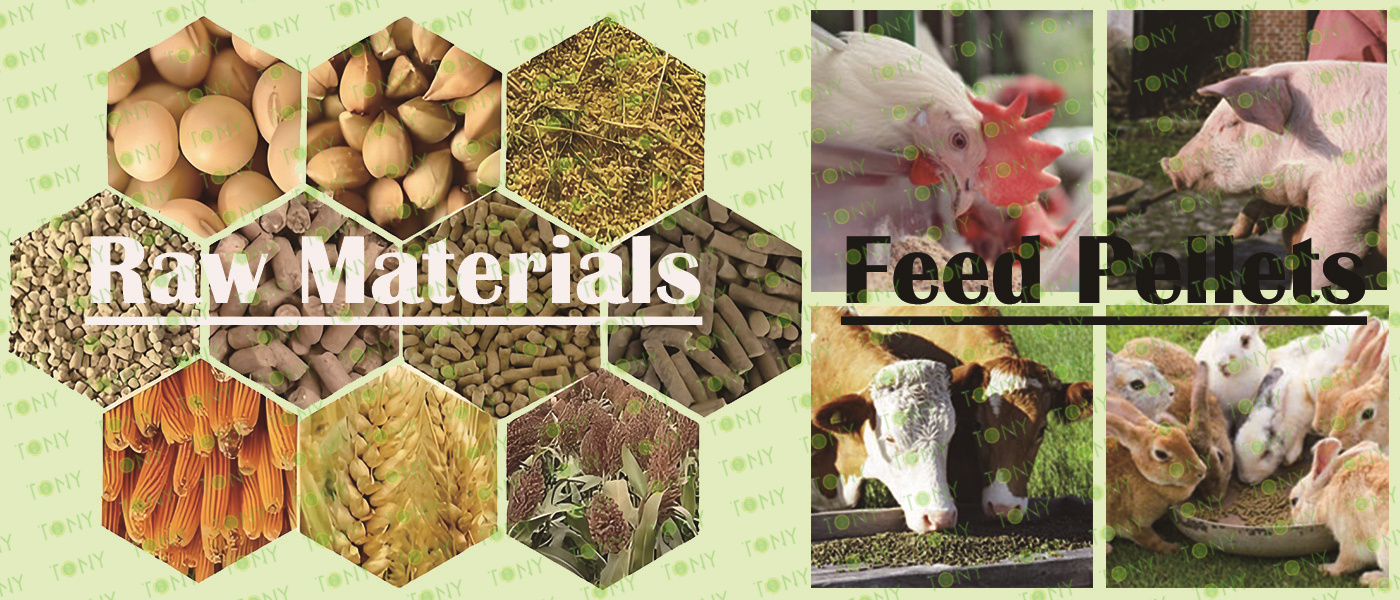

The economic benefits of Cattle feed pellets can be analyzed from multiple angles, including cost savings, nutritional value improvement, and environmental protection. The following is a detailed analysis :
1. Cost Savings
(1) Raw Material Utilization Rate
The feed pellets can mix a variety of raw materials together to suppress it, which can reduce the waste of raw materials, improve the economic benefits of mixed feed, and save costs. For farmers, the cost of making feed by itself is much lower than the feed in the purchase market. Although purchasing a feed pellet machine requires a certain amount of investment, in the long run, more expenses can be saved through homemade feed.
(2) Reduce The Waste Of Feed
Granular feed can avoid animal picking, reduce classification and reduce waste and loss. Due to the narrowing volume of pellets feed, it can shorten the eating time of cattle and reduce the nutritional consumption caused by food and poultry due to feeding. In addition, the granular feed can remain uniformly in the process of storage and transportation and feeding, which can reduce feeding loss by 8%~ 10%
2. Increase Nutritional Value
(1) Improve The Conversion Rate Of Feed
In the process of granularity, due to the comprehensive effect of moisture, temperature and pressure, some physical and chemical reactions have occurred, such as starch paste and enzyme activity enhancement, which enables the fed cattle Increase. Feeding poultry and pigs with pellet feed can increase the feed conversion rate (ie, the rate of return) by 10%-12%compared with the powder.
(2) Killing Harmful Microorganisms
The method of granular feed through high temperature adjustment and re -granularity can kill Salmonella in the existing Cattle feed, which can reduce the risk of Cattle disease and increase the benefit of breeding.
3. Environmental Protection
(1) Reduce Environmental Pollution
Granular feed can avoid automatic grading of feed components and reduce environmental pollution. During the powder storage and transportation process, due to the different volume of the powder, it is easy to generate grades. After the pellets are made, there is no grading of the feed component, and the pellets are not easy to settle. During the feeding process, the pellet material has much less pollution to air and moisture than powder.
(2) Save Resources
The granular feed density is large and the volume is reduced, which can save positions and save transportation costs. This can significantly reduce operating costs for large -scale farms.
In summary, Cattle feed pellets have shown significant economic benefits in many aspects. By increasing raw material utilization, reducing feed waste, increasing nutritional value, killing harmful microorganisms, reducing environmental pollution, and saving resources, granular feed brings real economic benefits to farmers and feed manufacturers. Therefore, in the long run, the production of the production of feed pellets and pellets is worth it.
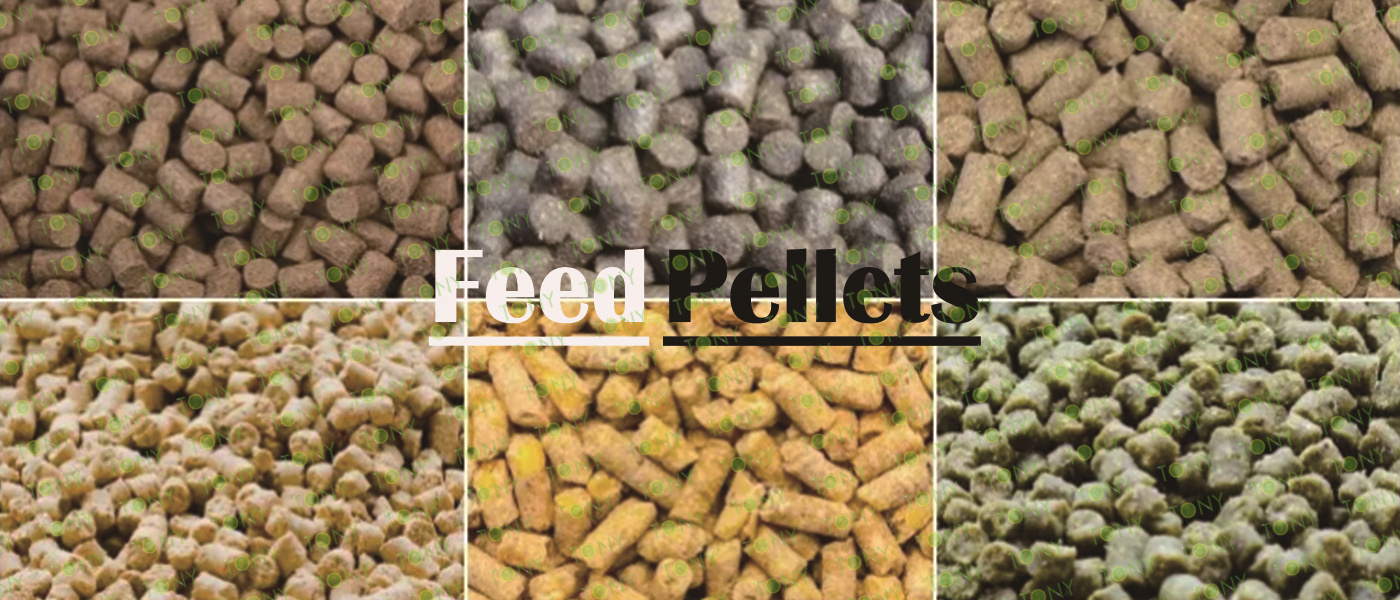

1.Advantages Of Feed Processing Plant:
(1)Easy To Change The Feed Formula: You can easily add trace elements, vitamins, health cares, and antioxidants in the feed.
(2)Improve The Utilization Of Nutrients: During the suppression process, the structure of some substances in the feed changes, thereby improving the utilization of some nutrients in the feed.
(3)Easy To Pack And Store: packaging and storage of feed pellets are more convenient. It is conducive to transportation and reduce transportation costs.
(4)Reduce The Infection Of Toxic And Harmful Bacteria: During the suppression process, the feed pellets can reduce or eliminate the toxic and harmful bacteria in the feed.
(5) Ensure The Quality Of Feed Products: The feed pellets ensure the quality of the feed products to a greater extent.
(6)Reduce Dust Pollution: Feed pellets reduced the dust to environmental pollution.
2.The Advantages Of Beef Cow Feed Feeding Field:
(1)Easy To Transport, Store And Save: Feed pellets are easy to transport, store and save.
(2)Reduce Feed Loss: The feed pellets reduce the amount of feed loss.
(3) It Is Conducive To Feed Distribution: Feed pellets are conducive to the distribution of feed.
(4)Improve Hygiene Conditions: granular essential feed improves the hygiene conditions of the bull farm.
3.Advantage Of Cattle
(1) Increase The Amount Of Feed: Cattle feed pellets, increased the amount of feed.
(2)Eliminate Picky Eaters: Feed pellets eliminates the problem of picking feed.
(3)Improve The Digestion And Conversion Rate Of Feed: The feed pellets improve the digestive rate and conversion rate of the feed.
(4)Improve Weight Gain: Feed pellets increase the weight of fattening cows.
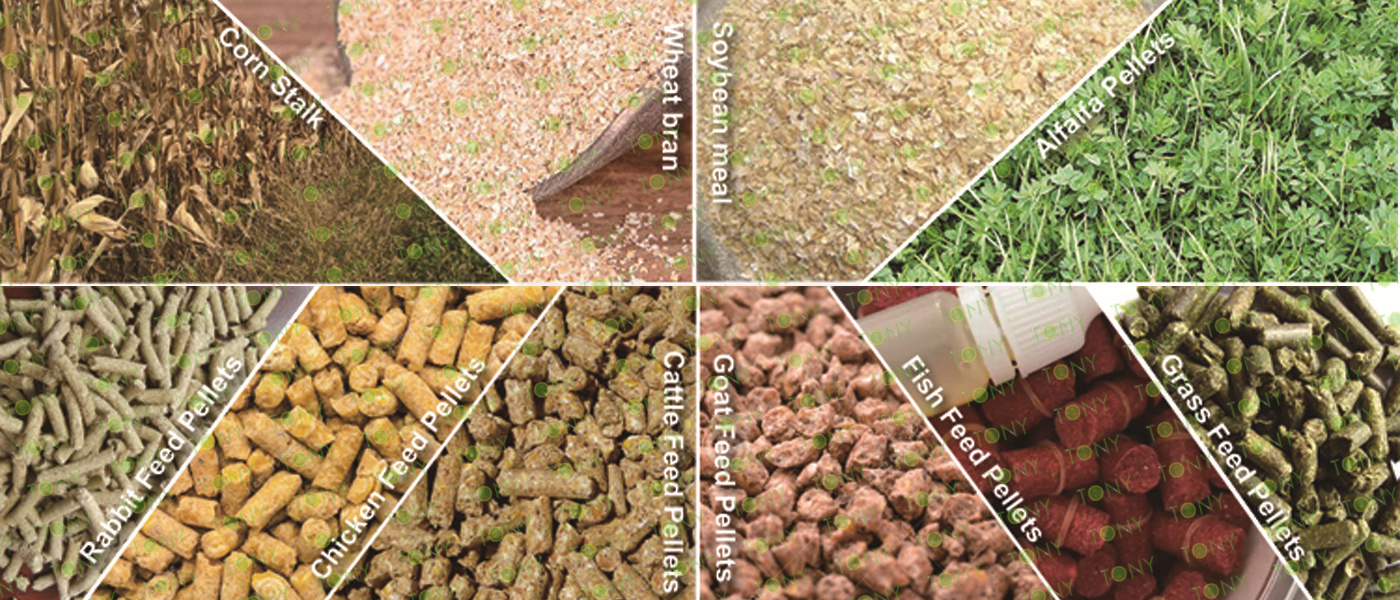

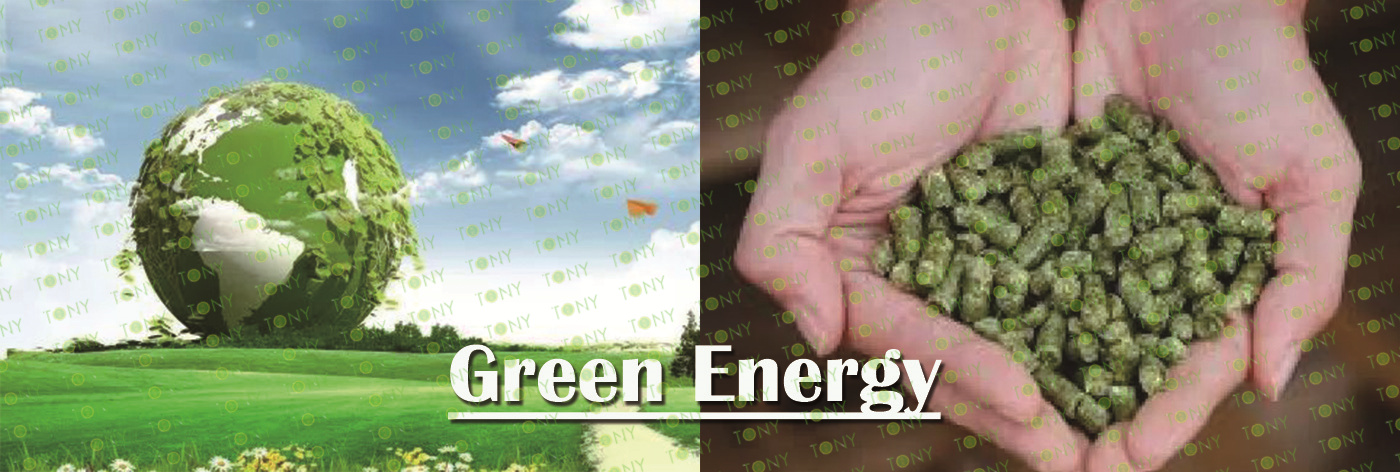
1. The Current Situation And Development Trend Of The Industry
Cattle feed pellets are processed into feed pellets such as crop straw, grain and other raw materials, and are widely used in animal husbandry. With the development of modern farming, the requirements for feed quality and production efficiency have been continuously improved, and the technology of beef feed pellets has also improved. At present, beef feed pellets have not only improved significantly in production capacity. By optimizing the voltage molding and ring mold design, the granular forming rate has been improved; it is also improved in equipment maintenance, such as wear -resistant materials and automatic lubrication systems.
2. Market Demand Analysis
Global cattle feed pellets are expected to continue to maintain a steady growth in the future. The global market feed industry is expected to further develop, optimize the feed utilization and feed planting model, standardize the production and use of feed additives, and encourage the development of high -quality feed.
3. Future Development Prospects And Strategic Suggestions
The future development trend of the beef feed pellets industry includes technological innovation and intelligent development, green environmental protection and energy conservation and emission reduction trends, customized and personalized service trends, and domestic and foreign market integration and expansion. In order to seize these opportunities, enterprises should adopt product innovation and differentiation strategies, market expansion and channel optimization suggestions, industrial chain integration and collaborative development strategies, risk management and response strategies.

1. The Working Principle Of Cattle Feed Pellet Processing Equipment
Feed raw materials for cattle, such as various crops or straw (corn, rice husks, straw, etc.) or various grasses, as well as other nutrients needed by animals (if added), into the feed pellet machine. When the machine is energized, the power is transmitted by the motor to the grinding disc in the press room to drive the press roller to rotate, and the raw materials will become mushy under the rolling of the two press rollers. In this process, the friction between the roller and the template will produce high temperatures, making the starch in the raw material mature and the protein solidify and denature. The raw material is extruded from the template hole under the press roll extrusion to form a cylindrical feed prototype. The feed prototype is sent out of the machine through the dump pan, and then the extruded feed is cut into pellets through the adjustable incision, and the particles can be packaged and stored after cooling.
2. Characteristics Of Cattle Feed Pellet Processing Equipment
(1) Simple Structure, Wide Adaptability: Small footprint, low noise, suitable for a variety of farming scenes.
(2) Dry Material Processing: Granulation can be performed without or with a little liquid addition, and the water content of pellet feed is close to the water content of the material before granulation, which is easy to store.
(3) High Economic Benefits: Compared with mixed powder feed, pellet feed can obtain higher economic benefits.
(4) The Processed Particles Are Of Good Quality: The produced feed pellets have high hardness, smooth surface and internal ripening, which can improve the digestion and absorption of nutrients
3. Application Scenarios Of Cattle Feed Pellet Processing Equipment
Cattle feed pellet processing equipment is widely used in the livestock industry, especially in the production process of cattle and sheep feed. This type of equipment not only improves the utilization of feed and the digestibility of animals, but also greatly simplifies the feed processing process, making it more efficient and convenient.
(1) Cattle And Sheep Feed Production Line
Cattle and sheep feed production line includes raw material reception and storage, cleaning (impurity removal), crushing, batching, mixing, granulation, cooling, crushing, grading, finished product packaging storage and distribution and other processes. Feed pellet machine plays an important role in this process, especially in the granulation process, which can process various feed raw materials into pellets for easy storage and transportation.
(2) Beef Cattle Raising
In the process of raising beef cattle, feed quality directly affects its growth rate and meat quality. Pellet processing equipment ensures the uniform distribution of nutrients in feed through the precise pelleting process, thus improving the growth efficiency and meat quality of beef cattle.
(3) Other Animal Feed
In addition to cattle and sheep feed, pellet processing equipment can also be used for feed processing of other animals such as pigs, chickens, ducks, etc. This processing method is not only suitable for traditional feed raw materials, but also can process organic waste and biofertilisers to achieve the recycling of resources.

1.Project Name:Cattle Feed Pellet Line
2.Raw Materisl: Soybean meal, corn, wheat bran, other minerals, vitamins, etc
3.Moisture Of Raw Material: Dry Type 10-15%
4.Capacity: 6-7Ton/Hour
5.Process: Dosing Process→Mixing Process-Pelleting Process-Cooling Processs-Packing Process
6.Main Machine: TONY Batching Scale, TMR Mixer, TONY Pellet Machine TYJ551-Ⅲ-132KW,TONY Pellets Cooler, TONY Packing Machine And Belt Conveyors
Total Power: About 880KW
Need Area: About 1200-1400㎡
Project Country:Pakistan
Voltage: 220V,50Hz

TONY Brand 6-7 tons/hour cattle feed pellet production line can process corn, soybean meal, soybean, rice husk, straw, alfalfa and other raw materials into high quality feed pellets. According to the nutritional needs and growth stage of cattle, determine the appropriate feed formula, prepare various raw materials according to the proportion of formula, and press feed into feed pellets under high temperature and pressure. Feed pellets not only improve the nutritional value and digestion and absorption rate of feed, but also simplify the feeding and management process
1.Capacity: 6-7 Ton/Hour
2.Raw materials: Soybean meal, corn, wheat bran, other minerals, vitamins, etc
3.Moisture: Dry type, about 10-15%.
4.Application: All kinds of animal feeds
5.Suitable Customers: Large farms and feed processing plants, these customers often need a large number of animal feed pellets, and have high requirements for production efficiency and product quality
6.Finished Pellets Markets: Application scenarios are very wide, covering poultry, livestock, pets, aquatic products, farms and zoos and other fields.

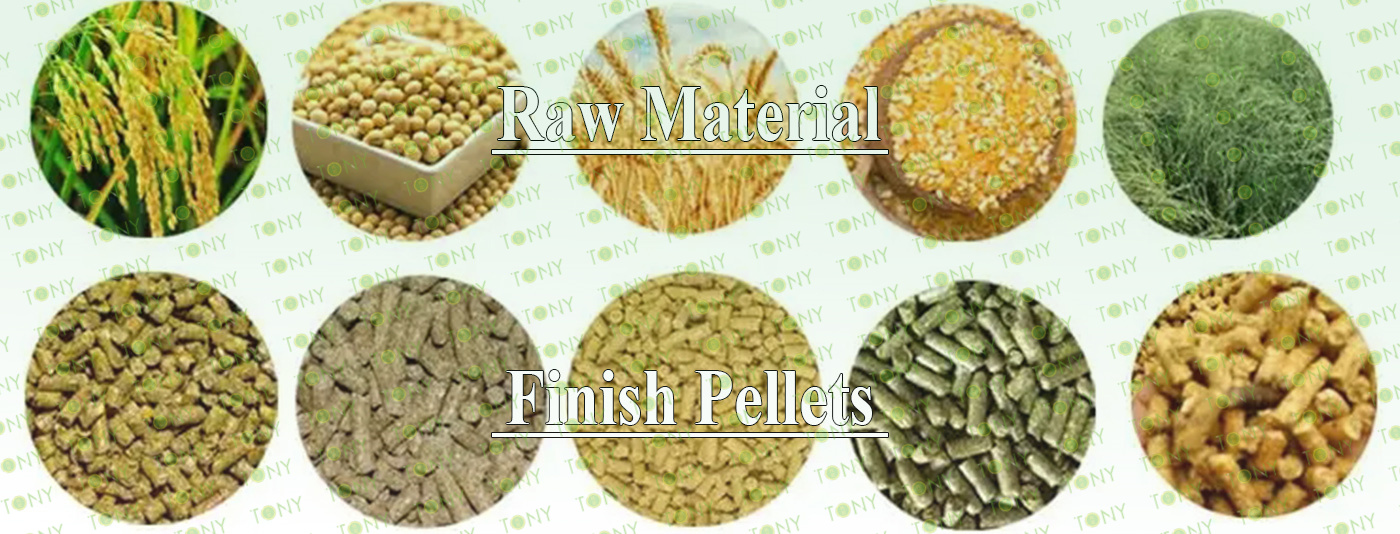
|
Project Brief Introduction: 1.Product: Cattle Feed Pellet Line 2.Capacity: 6-7Ton/Hour 3.TONY Brand 6-7Ton/Hour Cattle Feed Pellet Line Project Process 4.Main Machine: TONY Batching Scale ,TMR Mixer, TONY Pellet Machine TYJ551-Ⅲ-132KW, TONY Pellets Cooler, TONY Packing Machine And Belt Conveyors 5.Total Power: About 880KW 6.Need Area: About1200-1400㎡ 7.Country: Pakistan |
Project Layout For Customer |
|
|


|
How to use TONY pellet line to proceed cattle feed pellet? It mainly contains the following steps and machines as following: 1.To Use TONY Batching Scale To Batch Raw Material Into Formula . 2.To Use TONY TMR Mixer To Mix Formula 3.To Use TONY Vertical Ring Die Pellet Machine To Products Cattle Feed Pellets With φ4-8mm. 4.To Use TONY Galvanised Cooler Separator To Cool Cattle Feed Pellets. 5.To Use TONY Semi-Auto Packing Machine To Pack Pellets To 15-50Kg/Bags. You Can Contact TONY To Get For More Details Information And Quotation. TONY Can Supply You All The Products As Above With Competitive Price And Excellent Quality. |
|
|||||||||||||||||||||||||||||||||||||||||||||



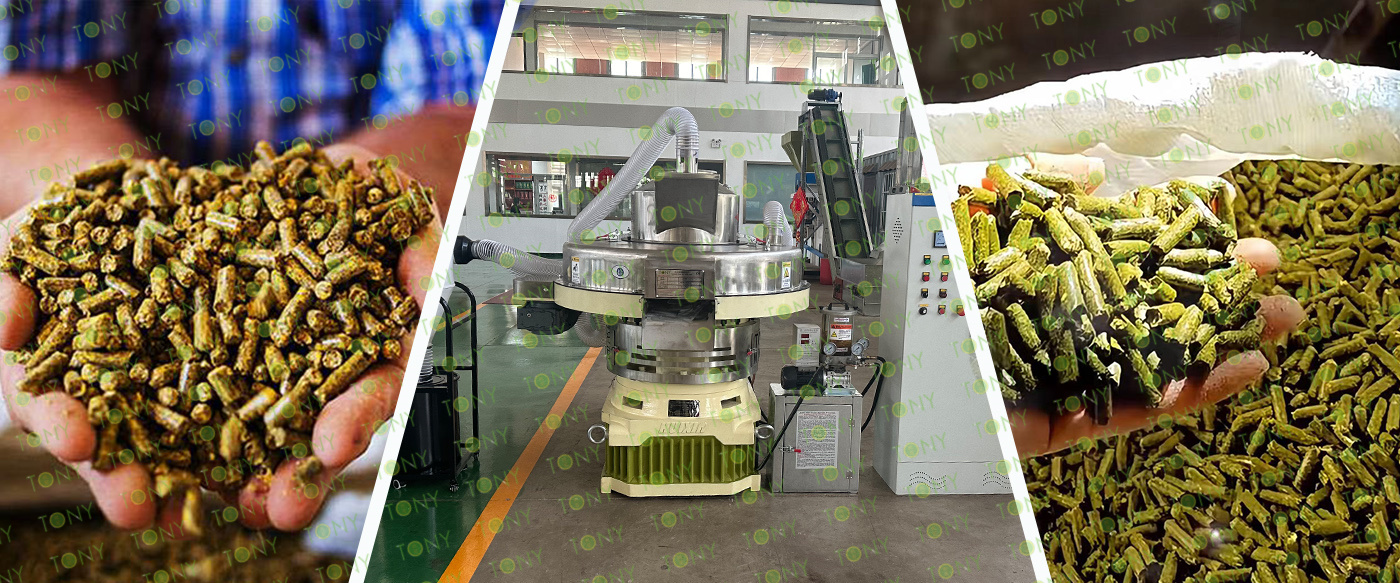
Following TONY Will Introduce For You For All The Necessary Machinery That Will Be Used For The Whole Pellet Production Line. Some machines can be custom made by customer according to different customer's detailed demand.Contact TONY for more details with quotation and layout.
|
|
|
|
|
Batching Scale |
TMR Mixer |
Vertical Ring Die Pellet Machine |
|
1.To Weight And Quantitative Control Materials According To Formula Ratio 2.Variable Frequency Control Adjustment Of Powder Material Flow |
1.To Mix Formula Makes The Various Raw Materials More Uniform 2.Model: T9JGW-9 |
1.Model: TYJ551-Ⅲ-132KW*3 sets 2.Capacity:2-2.5Ton/Hour/Set 3.New 304SS Type |
|
|
|
|
|
Galvanised Cooler Separator |
Semi- Auto Packing Machine |
El Cabinets |
|
1.To Cool Pellets From 80-90℃ to 20-30℃ 2.Model: TCN-4 3.Capacity:6-7Ton/Hour |
1.Packing Pellets To 15-50KG/Bags. 2.Model:TBF-50*2sets 3.Capacity:6-7Ton/Hour |
1.Control Cabinets As Above 2.Quanity:6 Sets 3.Capacity:Designed With The Whole Line |

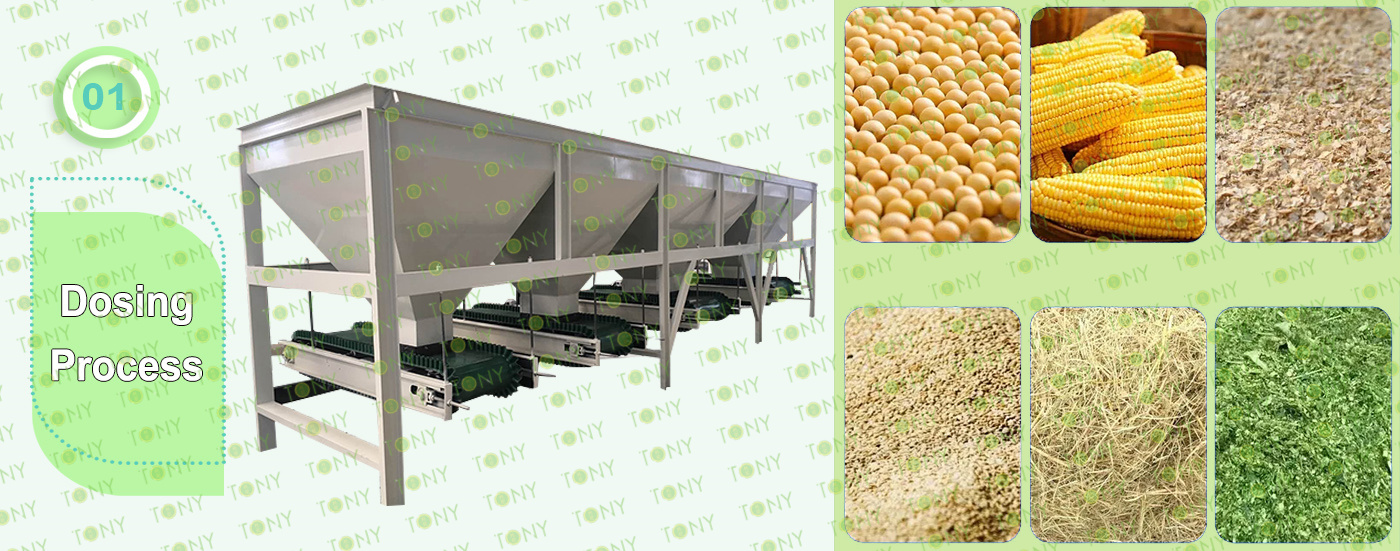
1. Dosing Process
A. The process is mainly used to automatic dose of raw material such as soybean meal, corn, wheat bran, other minerals, vitamins, etc in formula ratio.
B.The static ingredient system also has the speed of dynamic ingredients and the accuracy of ordinary static ingredients
Main parts:
(1)Material Storage
(2)Weighing Belt
(3)Cylinder
(4)Solenoid Valve
(5)Control Cabinet

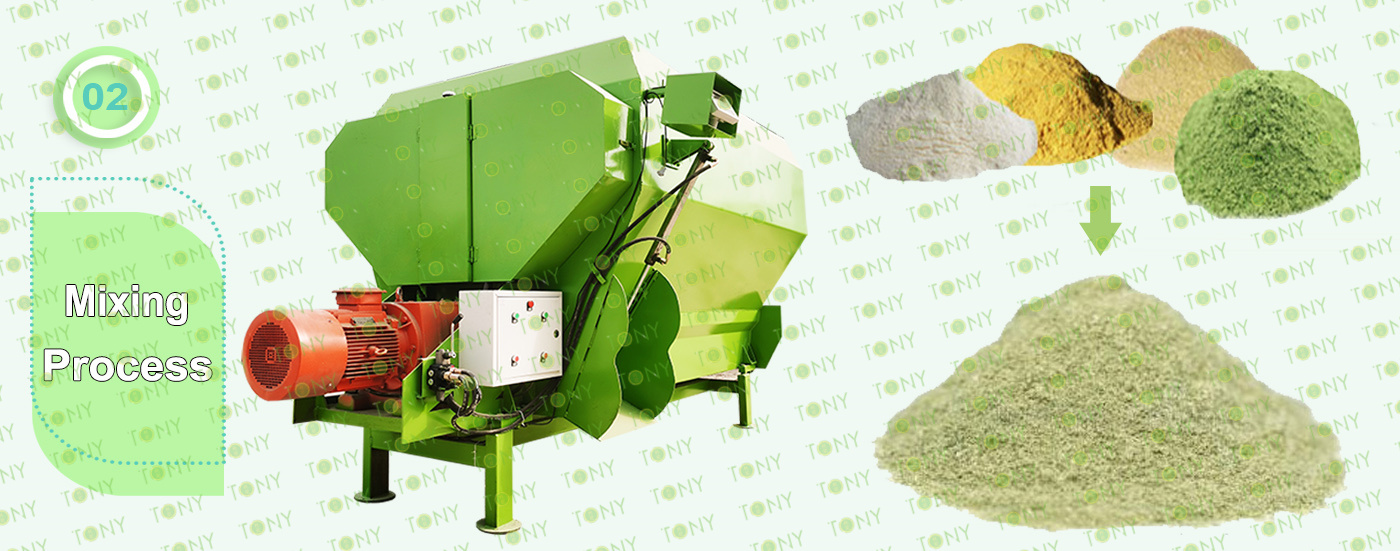
|
2.Formula Mixing Process: A.This process is mainly used to mix the formula to make it even. B.This process customer uses 1 set TMR Mixer,the precise mixing process ensures that each feed contains a variety of nutrients, thus increasing the efficiency of livestock production C.Main parts: (1)Auger System (2)Discharge System (3)Feeding System (4)Weighing And Measuring System (5)Transmission System |
|


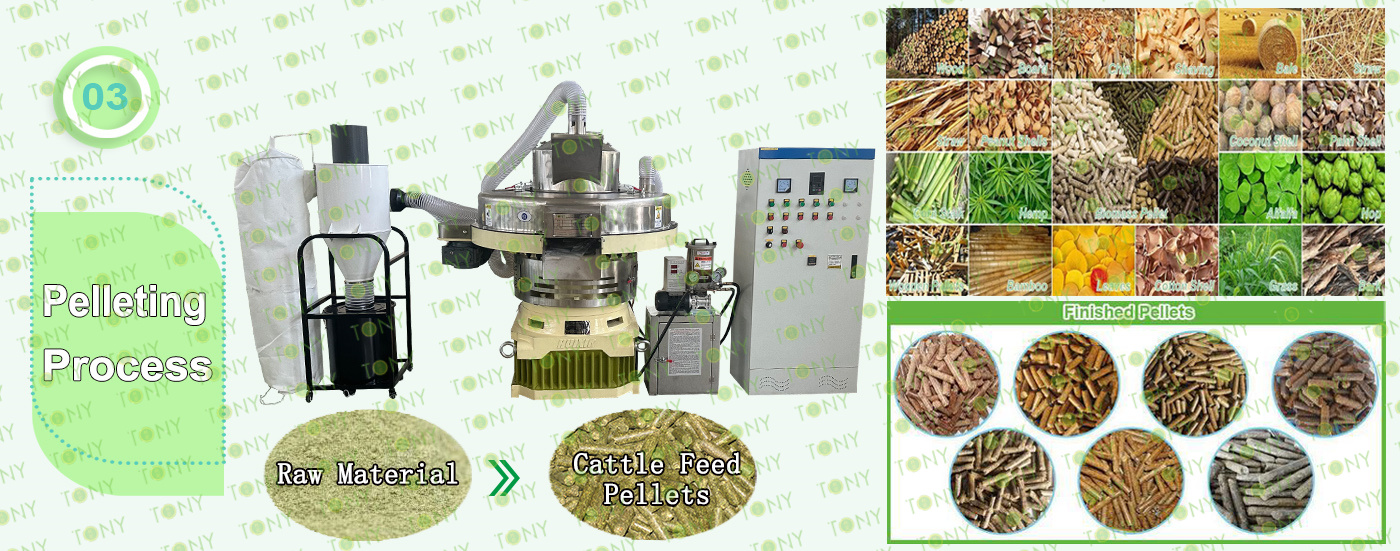
|
3.Pelleting Process: A.This process is mainly used to product cattle feed pellets with φ4-8mm. Biggest Capacity: 2-2.5 Ton/Hour/Set. C.The customer chooses 3 sets of TONY brand Vertical Ring Die Pellet Machine TYJ551-III-132KW Total Capacity 6-7 Ton/Hour. Main Parts: (1)TONY's new Vertical Ring Die Pellet Machine. (2)Cyclone And Bags Dust Collectors. (3)Bearings Automatic Lubrication System. (4) Electrical Babinets. You can choose TONY new Type SS304 Pellet Machine or old Type MS Pellet Machine. |
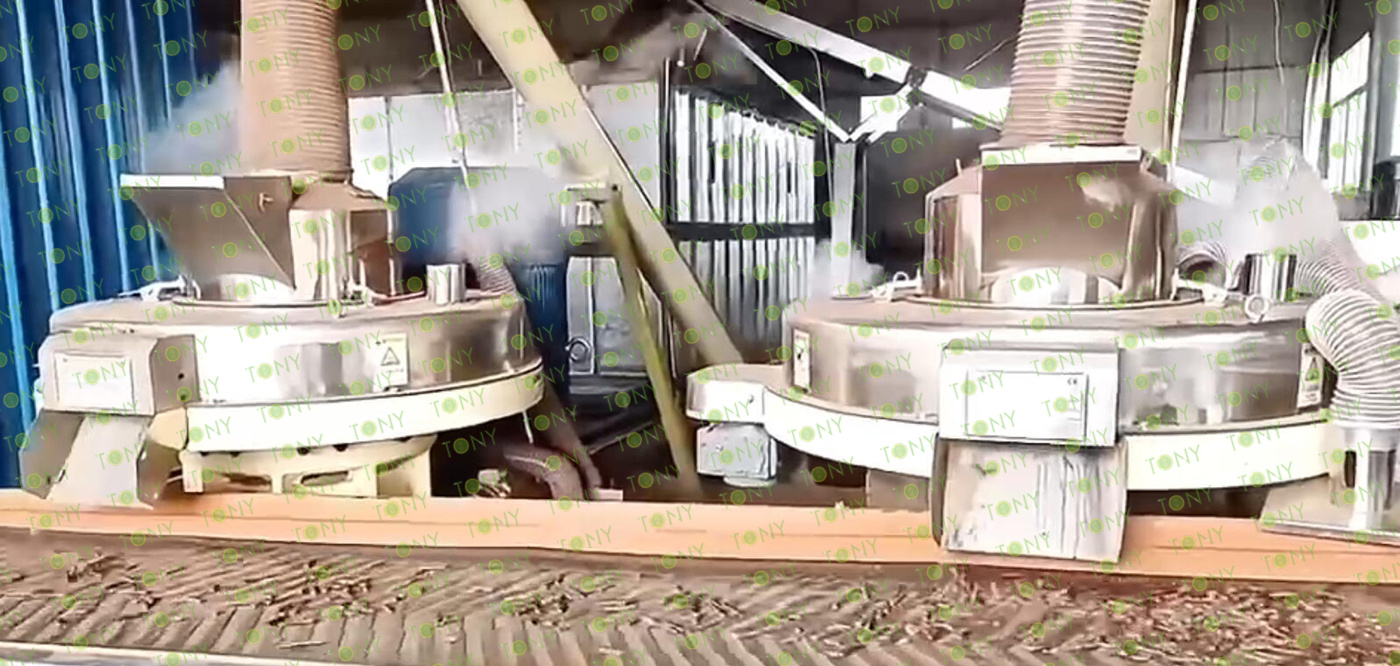

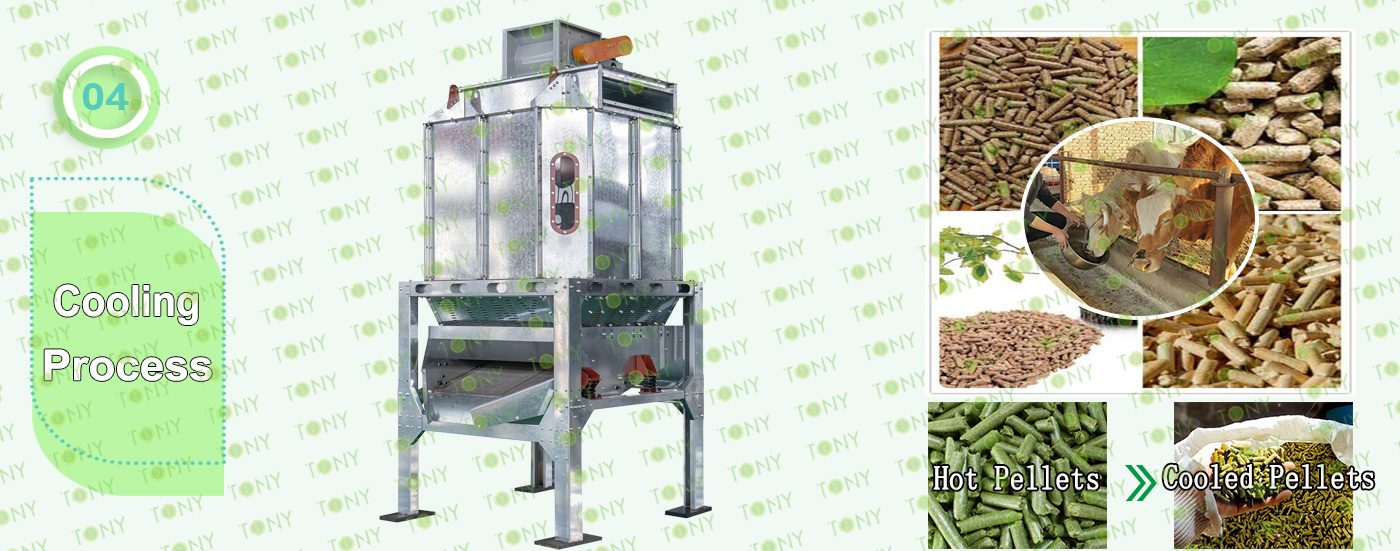
4.Cooling Process:
A.This process is mainly used to cool the pellets
B.The customer chooses 1 set of TONY galvanised cooler Separator with capacity 6-7Ton/Hour
Main Parts:
(1)TONY's new Galvanized Cooler Separator With Vibrating Screen.
(2)Cyclone And Bags Dust Collectors.
(3)Fan Blower.
(4)Connect Pipes.
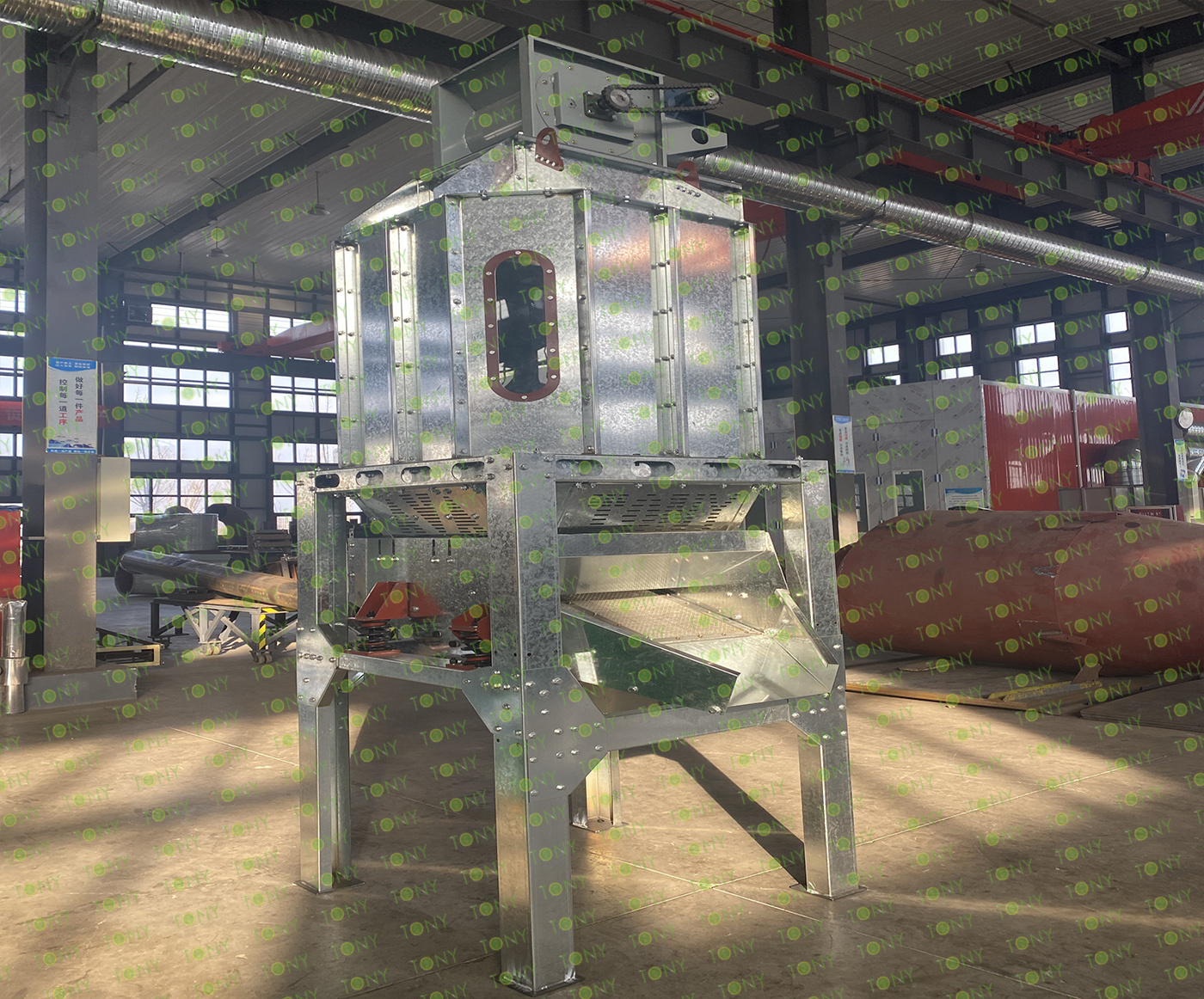


5.Packing Process:
A.This process is mainly used to packing pellets to 15-50KG/Bags
B.The customer chooses 2 sets of TONY Semi-Automatic Packing Machine
Main Parts:
(1)TONY's new TONY Semi-Automatic Packing Machine.
(2)Sew Machine, Buyer Can Also Choose Hot Seal Machine For Chosen,To Confirm With TONY For The Price Difference.
(3)Bags Transportation Conveyors.
(4)Feeding Inlet Silo
(5)Electrical cabinets.
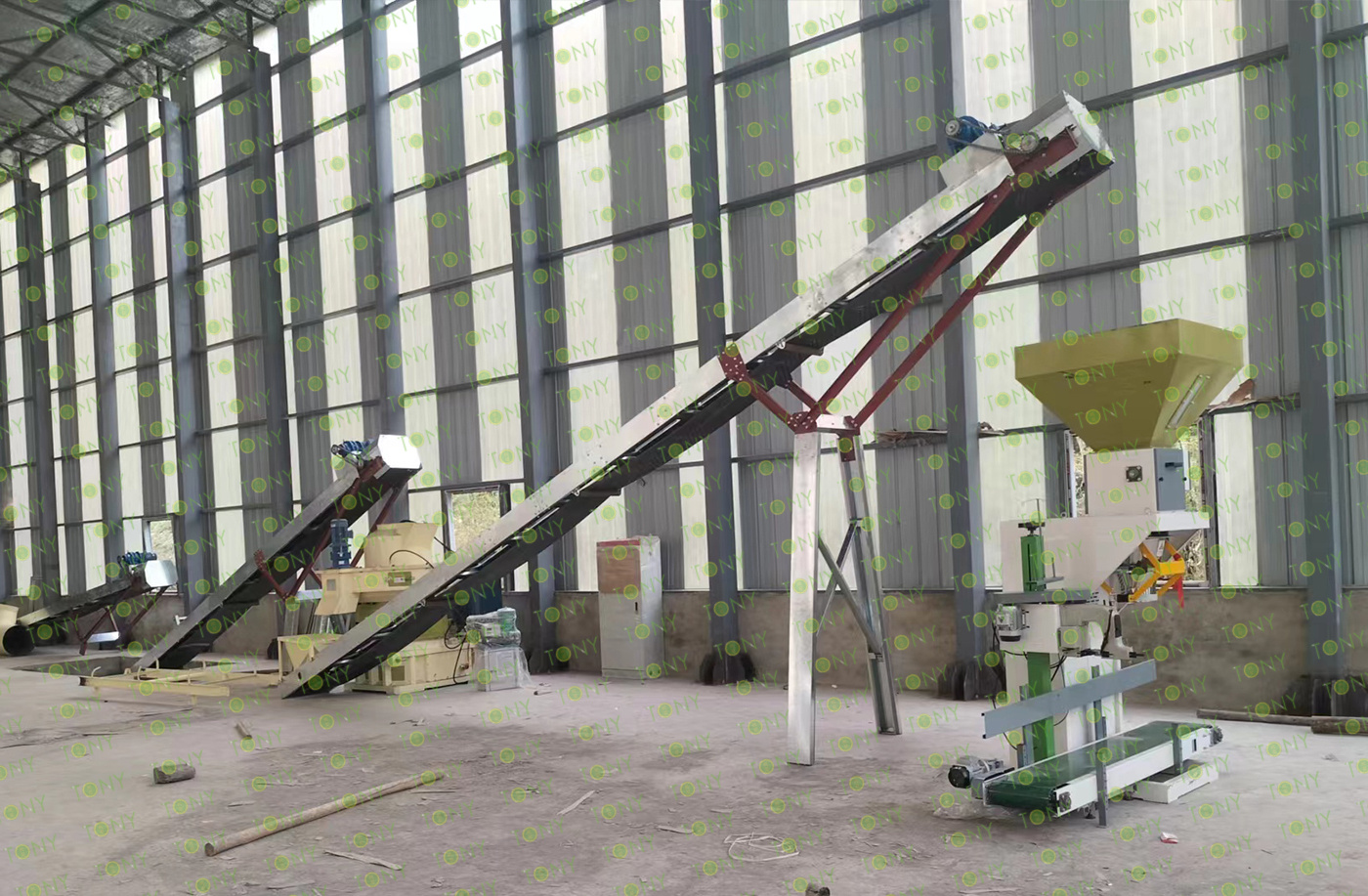

TONY Detailed Design 3D Layout With Detailed Size For 6-7Ton/Hour Cattle Feed Pellet Line According To Cusomer Factor Size
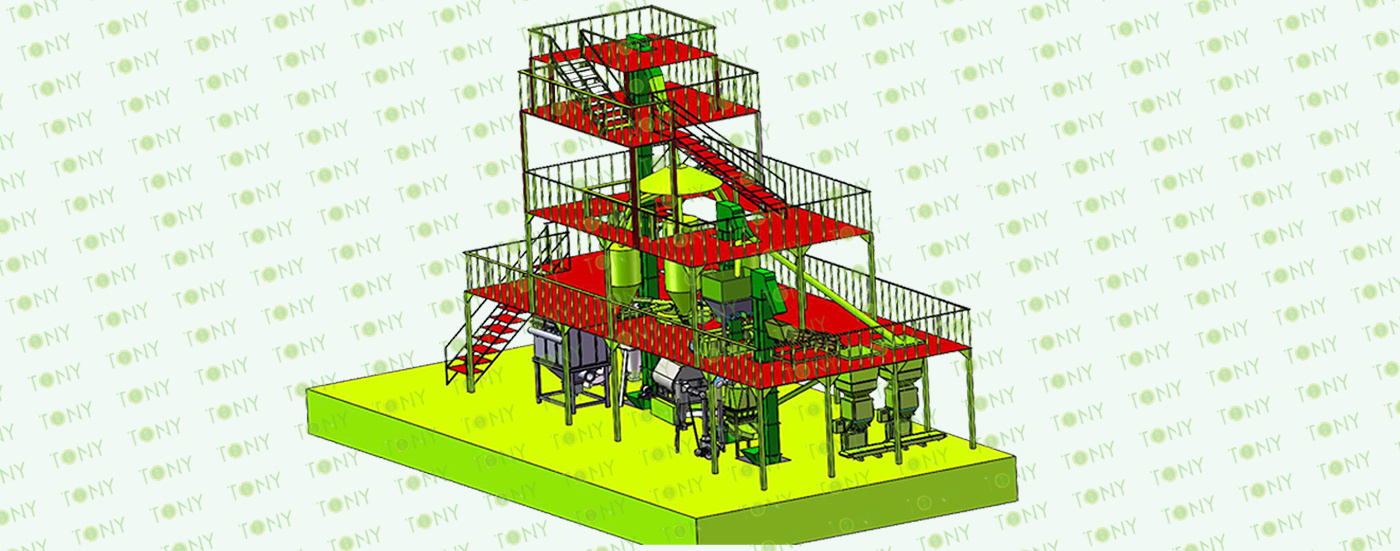

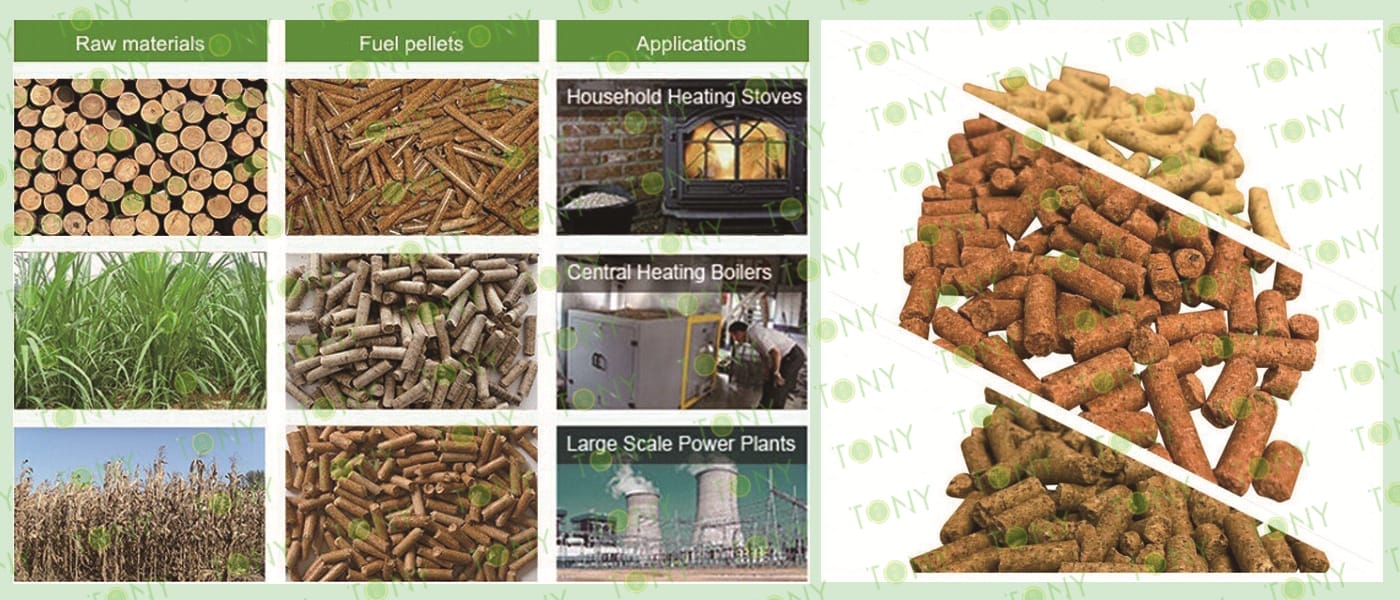
Cattle feed pellets have many advantages, which are mainly reflected in the following aspects:
1. Improve Feed Utilization Rate
In the pelletizing process of pellet feed, due to the combined action of water, temperature and pressure, some physical and chemical reactions occur in the feed, starch gelatinization, and enzyme activity is enhanced, which can make the fed animals digest the feed more effectively and convert it into weight gain. For example, feeding poultry and pigs pellets can increase the feed conversion rate (i.e. the rate of return) by 10-12% compared to meal.
2. Prevent Picky Eating And Unbalanced Nutrition
Pellet feed can prevent animals from picky eating, because the compound feed formula has a variety of raw materials and comprehensive nutrition, which can prevent animals from picking their favorite food from the powder and refusing to ingest other ingredients. Since pellet feed can maintain uniformity during storage, transportation and feeding, feeding loss can be reduced by 8%-10%.
3. Improve Palatability And Feed Quality
Molasses and grease can be added in the granulation process to improve the palatability of the feed. At the same time, pellet feed improves the quality of feed and has good palatability.
4. Reduce Environmental Pollution And Disease Transmission
There is no classification of feed components after the particles are made, and the particles are not easy to dust, and the pollution of the particles to air and water is much less than that of the powder in the feeding process. In addition, the use of steam pressure in granulation can also disinfect, sterilize and kill insects to reduce animal and poultry diseases.
5. Convenient For Packaging, Storage And Mechanical Feeding
Pellet feed is easy to pack, store and transport, not easy to deteriorate. At the same time, the size and specific gravity of pellet feed are uniform, and there is no stratification during transportation, so the uniformity of feed can be maintained.Pellet feed is most popular for large-scale cattle or poultry farms that use automated feeders.
6. Economic Benefits
Although the cost of pellet feed may be higher, the economic benefits are still considerable in the long run due to its improved feed utilization and reduced waste.

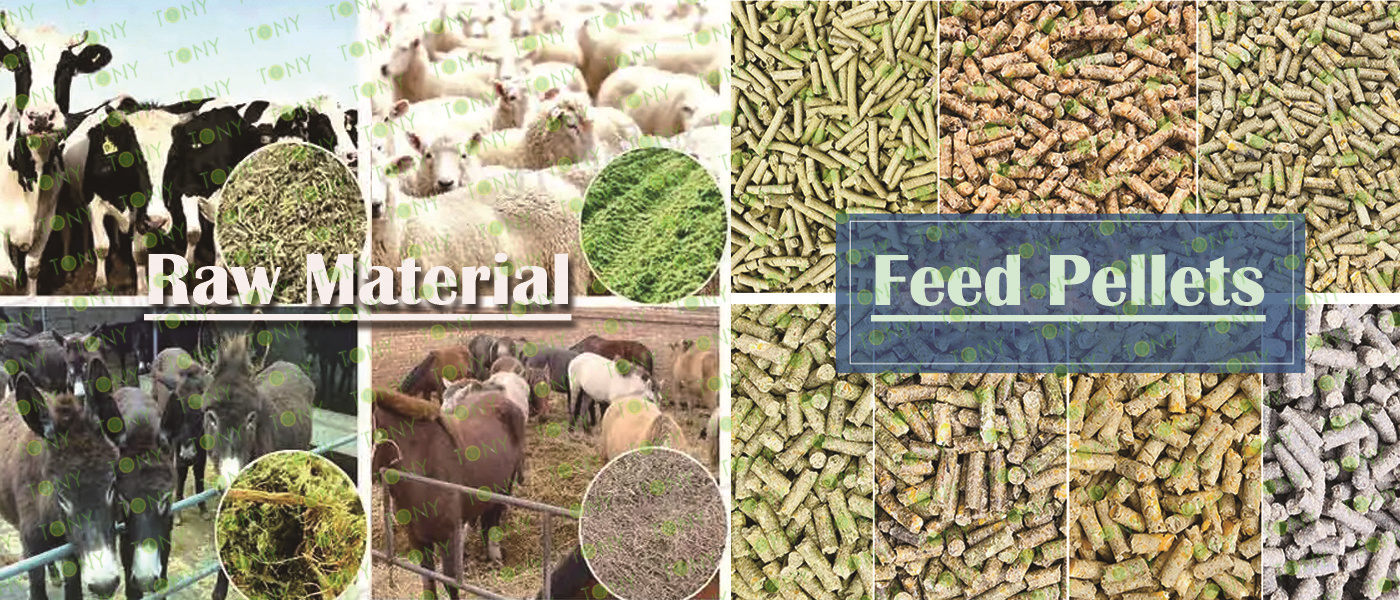
The market prospect of cattle feed pellet industry is very broad, with the following main advantages and trends:
1. Strong Market Demand:
With the large-scale and intensive development of animal husbandry, the demand for feed continues to grow. In particular, the implementation of environmental protection policies has put forward higher requirements for feed quality. Green, environmentally friendly and efficient feed pellet products are favored .
2. Considerable Profit Margin:
The investment scale of the cattle feed pellet plant is flexible and can be customized according to its own financial situation and market demand. Because of the high added value of cattle feed pellet products, the price is relatively stable, so the profit margin is large. At the same time, the production cycle is short, the capital turnover is fast, and the return cycle is relatively short .
3. Moderate Technical Threshold:
The production technology of cattle feed pellets is relatively mature, the equipment is highly automated and the operation is simple. Entrepreneurs do not need to have deep professional knowledge background, just through systematic learning and practice, they can quickly master the core technology .
4. Strong Policy Support:
The international attaches great importance to the feed industry and has introduced a series of supportive policies, such as tax incentives, loan support, technical training and so on. In addition, the local government will also formulate corresponding supporting policies and industrial planning according to the actual local situation, to provide strong support for the development of cattle feed pellet plant .
5. Complete Industrial Chain:
The industrial chain structure of the feed industry is relatively complete, covering multiple links such as raw material supply, feed production, sales and downstream breeding. This structure enables the feed industry to closely connect agriculture and animal husbandry, promote the effective use of resources and the coordinated development of the industry .
6. Technological Innovation And Intelligent Development:
The progress of automation and intelligent processing technology, as well as the application of energy-efficient materials in mechanical design, will further improve the production efficiency and product quality of cattle feed pellets.

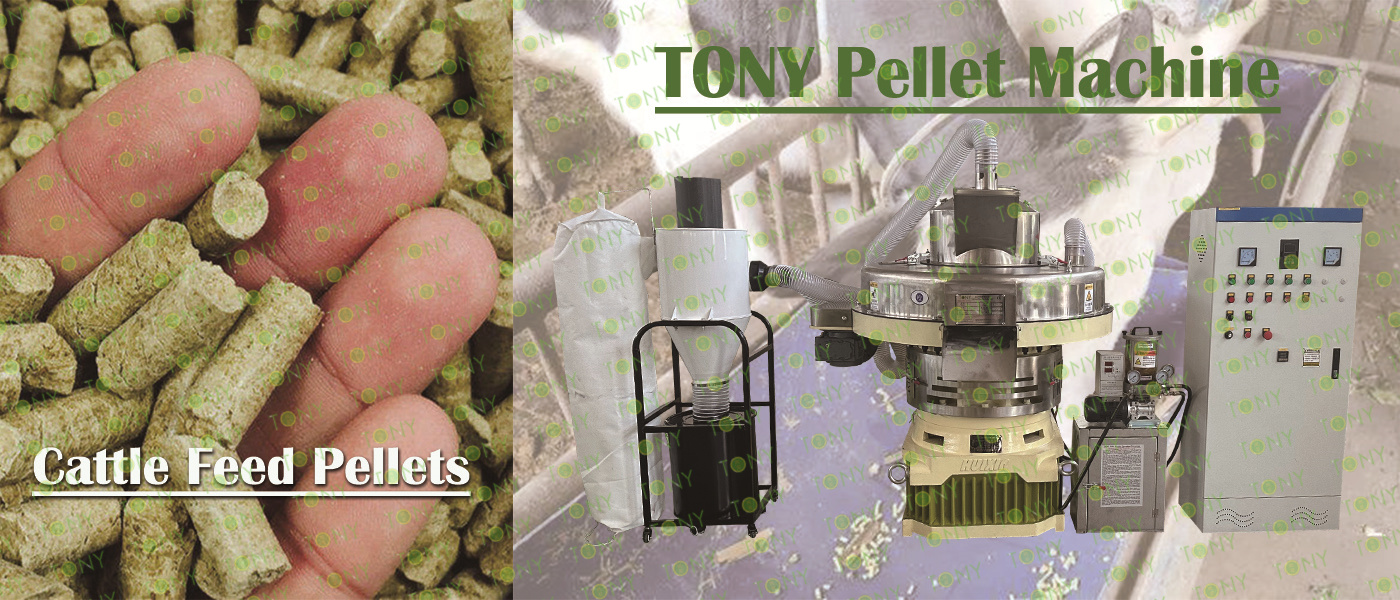
1. Project Overview
The aim of this project is to develop highly efficient pellets for low-discharge cattle, which not only help to improve the fattening effect of beef cattle, but also have significant environmental protection and economic benefits.
2. Technical Features
Cattle feed granules can effectively resist stress, reduce the incidence of disease, and improve the reproductive performance and fattening efficiency of cattle. In addition, feed utilization efficiency is high, nitrogen and phosphorus emissions are reduced, is an environmentally friendly feed.
3. Market Prospects
The products of the project have great demand and development potential in the market. The products of this project have reached the international advanced level, which is of great significance to promote the technological progress of the industry and increase the income of farmers.
4. Benefit Analysis
(1) Ecological Benefits:
After the implementation of the project, it can improve the ecological environment of the grassland and promote the sustainable development of animal husbandry. At the same time, providing a sufficient amount of high-quality raw materials for cattle and sheep products to support large enterprises to add value to their products has significant social benefits.
(2) Economic Benefits
In the total investment of the project, the specific amount of fixed asset investment and working capital is not listed in detail, but it is expected that the return on investment is high, showing good economic benefits.
(3) Social Benefits
The project can drive farmers in the region to get rich, increase farmers' income, and promote the process of agricultural industrialization, which has far-reaching significance for regional economic development.

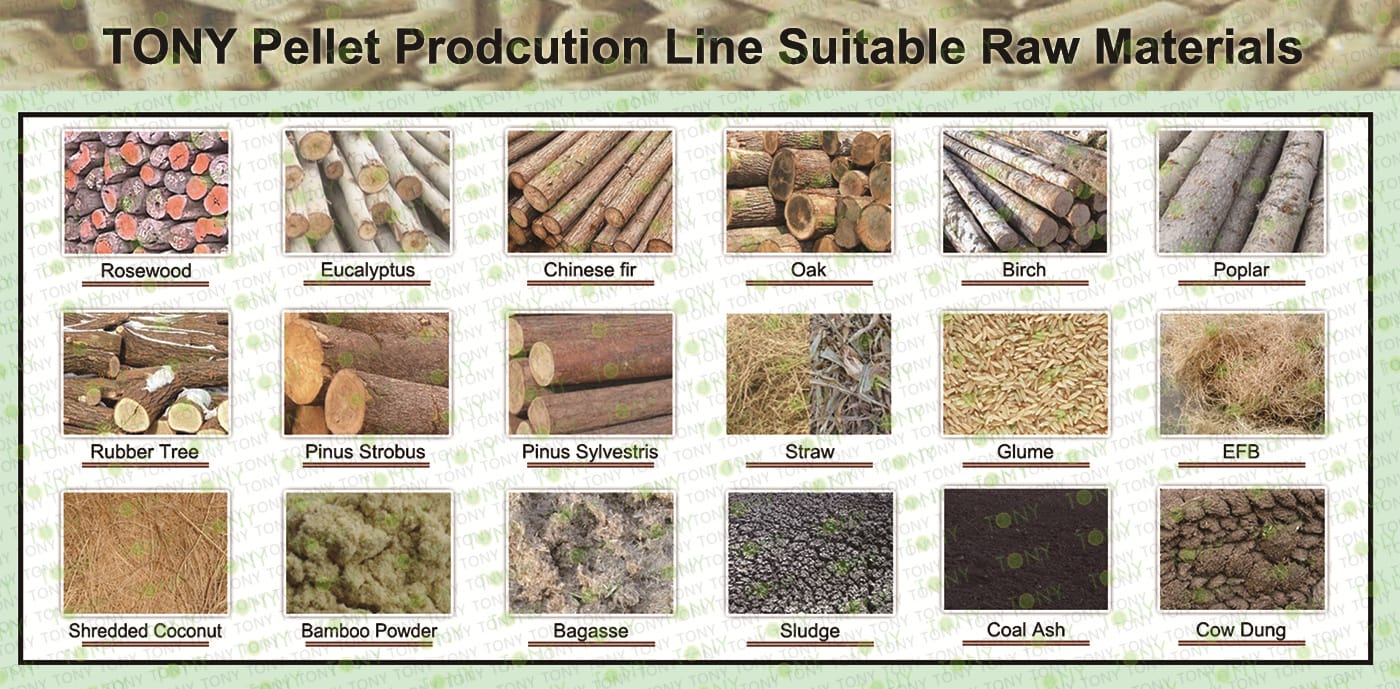
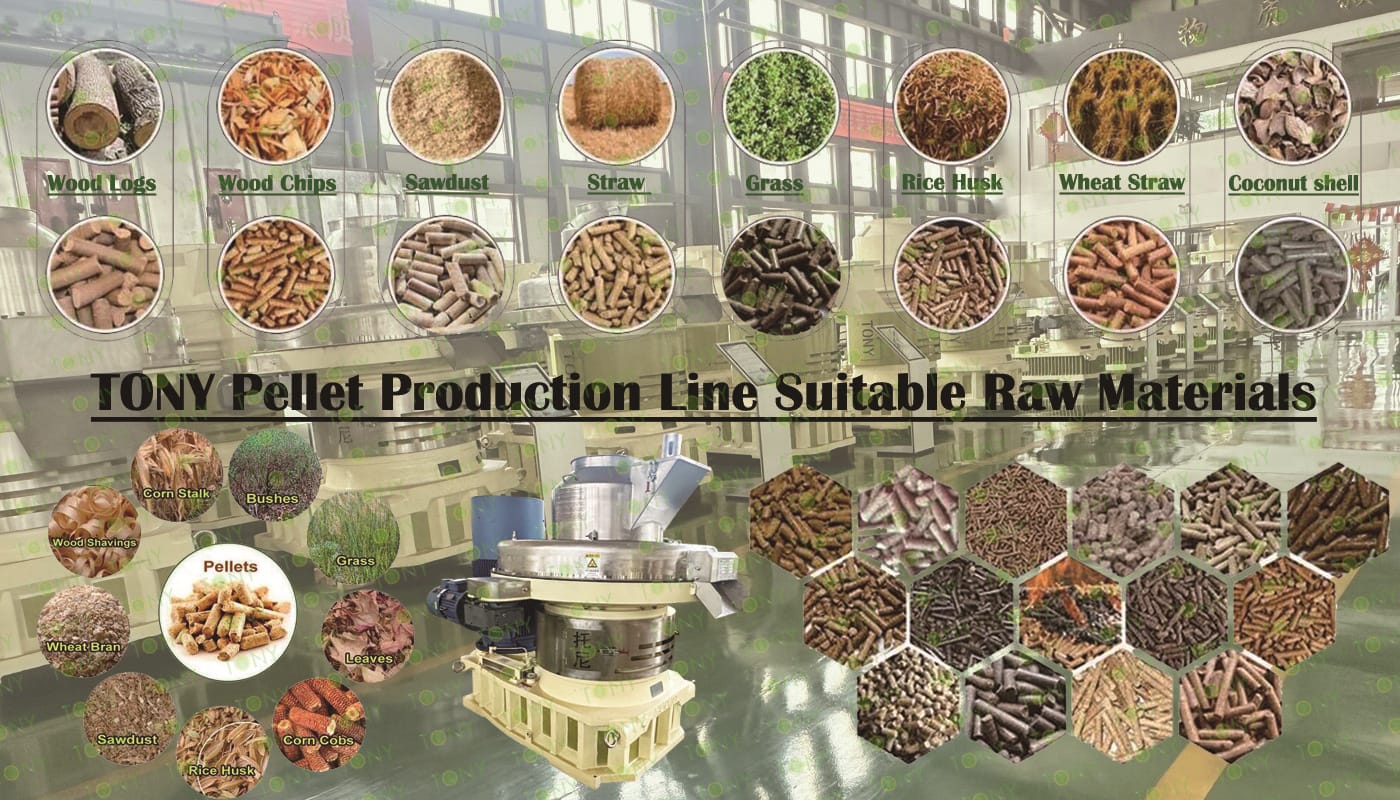

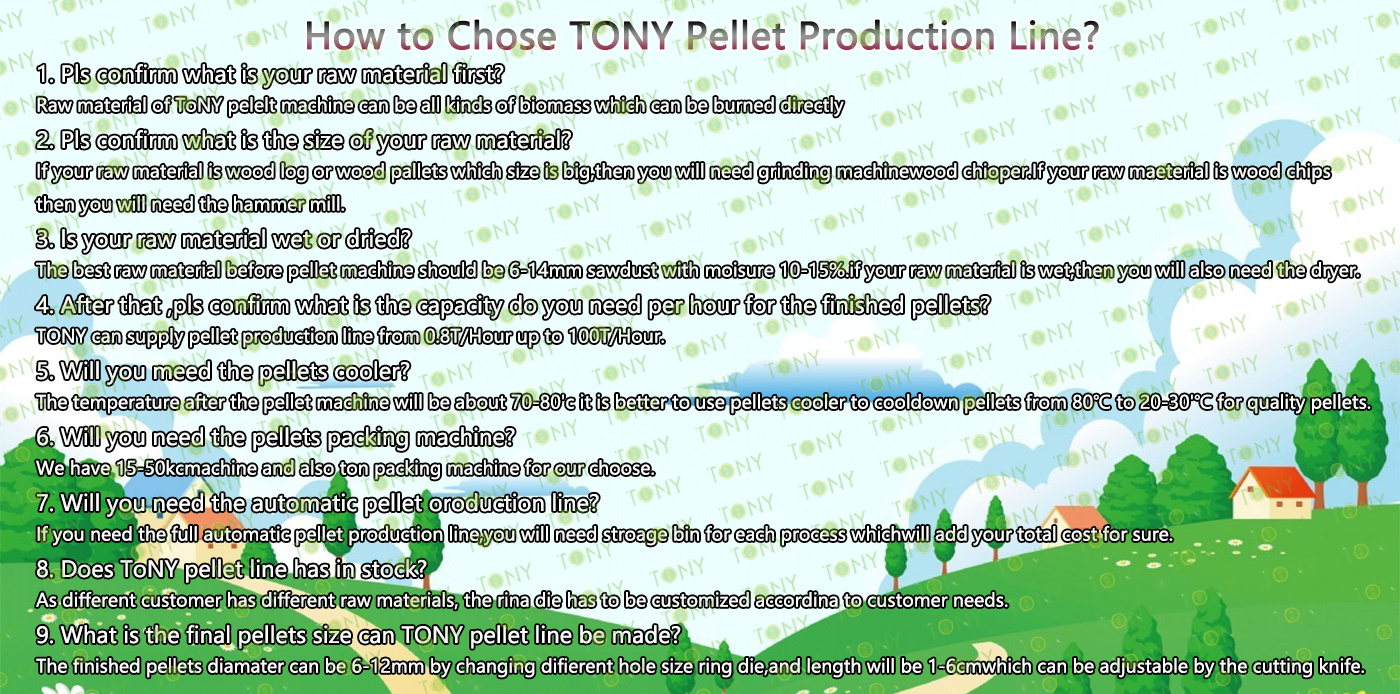

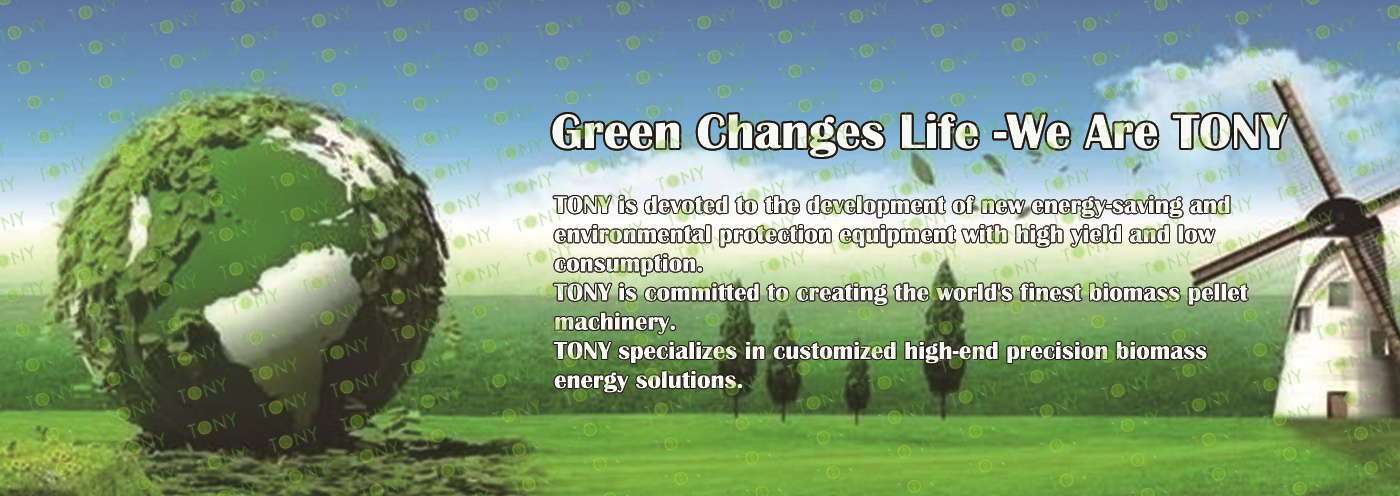
2025 Tony Machinery - All Rights Reserved. Map